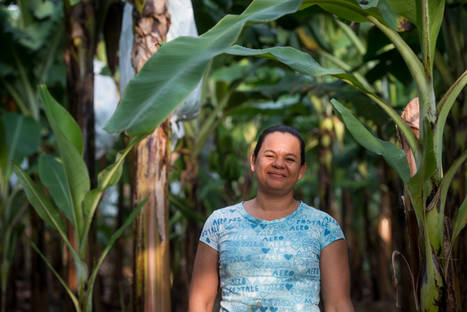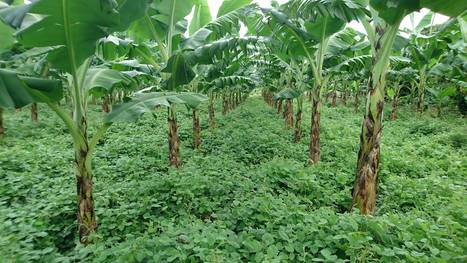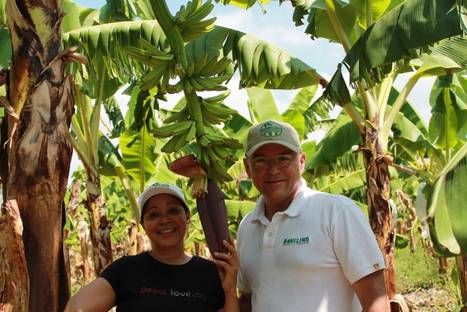Organic banana production in the Dominican Republic

The Dominican Republic is the largest producer of organic bananas worldwide, representing more than 55% of the world’s organic banana production. Despite being a relatively small player in the global banana market, the Dominican Republic stands out as its most important source of organic bananas, and is therefore a useful demonstration of common implementation methods, their results, and the challenges faced by producers wishing to change to organic methods. Banana production is concentrated in the Northwest provinces of Valverde and Monte Cristi, and the Southern prvinces of Azua and Barahona.
Factors influencing the development of organic banana production in the Dominican Republic:
- Low incidence of Black Sigatoka
- Low use of agricultural inputs
- High market demand for organic bananas, particularly in Europe
- Better market prices
- Environmental concerns in the banana industry, favouring the development of sustainable production.
- Availability of resources from the international community and NGOs to promote the sector.

Example of BANELINO
Example of BANELINO
BANELINO was created in 1996 and is an association representing more than 320 small producers in Azia, Montecristi and Valverde in the the northwest of the Dominican Republic, with 95% of their exports coming from the latter two provinces. The association's producers work for good management of natural resources, conservation of the environment and fair prices to improve living conditions for families and communities.
|
Actions performed by BANELINO organic producers include:
- Switching to certified and approved agrochemicals.
- Clearing fields of other species, removing competition plants, weeds and hosts for pests and diseases.
- Planting ten metre wide "streets" 90 metres from rows of banana trees, hosting numerous other fruit plants with different root structures and foliage types. Planting different species in these “streets” helps with identifying the best plants for specific areas and soil compositions.
- Planting crops alongside bananas such as cocoa, citrus, mago, avocado and guava.
- Cover crops were also planted extensively. Vigna (beans and legumes), Crotalaria (legumes and herbs), Canavalia (animal fodder and legumes) and Arachis (legumes) plants were used, sown both during the establishment of the field and throughout the growing season.
Pest control
Pests and diseases affecting organic banana plantations in the Dominican Republic include:
1. Common thrips (Frankliniella parvula) and red spot (Chaetanaphothrips orchidii)
Control: Use capsaicin, neem, garlic or cinnamon-based organic insecticides, saponified or potassium soaps and saturated efficient microbes in the soil.
2. Weevils (Cosmopolites and Methamasius)
Control: Traps, or with the fungal entomopathogens Beauveria bassiana and Metharhizium anisopli in certified organic commercial presentations.
3. Black Sigatoka4
Control: Removal of infested leaves, Melaleuca, citric acid, potassium, antagonistic micro-organisms and oils.
4. Pseudostem rot by bacteria such as Erwinia
Control: Applications of copper and antagonistic microorganisms are used to reduce the impact.
5. Radolphus similis
Control: Management of the organic matter of the soil, flood irrigation, inoculation of soil with microorganisms or nematicides such as the Paecilomyces spp.
Results
The practice of planting rows has resulted in the cohabitation of several species, allowing the creation of a sustainable system, and has achieved the following results:
✓ Increase in banana production despite reduced planting areas
✓ Efficient pest and disease control
✓ Improved soil quality through better moisture and soil temperature conditions
✓ Greater water efficiency in the irrigation process
✓ Increase in soil organic matter
✓ Better nutritional management of the plant
✓ Additional revenue from the other planted species, which are also organic. In the case of associating bananas with cocoa, it is important to consider that there is a beneficial relationship between Musaceae and cocoa, since banana plants are cocoa pollinators.
✓ There have been experiments implementing apiaries within the plot, using the streets as a place to put the boxes and cultivate multifloral honey, which is highly coveted and valued on the market. Using irrigation to complete the main crop water requirements allows the availability of flowers throughout the year, creating an ideal place for this type of exploitation.
Challenges
It is necessary to carry out studies that allow evaluating, validating and quantifying the real impact of methods used in organic production. Some of the issues that need to be studied are:
1. The effect of cover crops on the biological control of thrips. Using cover crops creates a suitable place for the development of organisms that reduce thrip populations.
2. Enhancing conditions for entomopathogenic fungi to reproduce, in order to decrease the number of weevil larvae and adults.
3. Increasing soil health and quality. Improvements to bacteria populations, actinomycetes and fungi appears to reduce the level of inoculum in Sigatoka-infested leaves.
4. Decreasing water stress by preserving humidity. Water stress causes several problems, including susceptibility to pathogens.
5. The presence of greater numbers and types of roots in the soil causes nematode damage to spread. It would beneficial to find nematode populations representative enough to assess their full effect on root systems.
6. The country is highly susceptible to climate change factors and weather variations, significantly affecting yields, soil health, and banana farmers’ livelihoods.

References
References
1 Potts, J., Lynch, M., Wilkings, A., Huppe, G., Cunningham, M., Voora, V. 2014. The state of sustainable initiatives review 2014: Standards and the Green Economy. 97-118 pp.
2 Ministerio de Agricultura. Sector Bananero Dominicano
3 FAO. 2013. FAO Realiza TallerInternacional sobre Estrategia de Mercado del Banano Dominicano
4 FreshFruitPortal. 2011. Black Sigatoka Fungus Hits Dominican Republic’s Bananas

